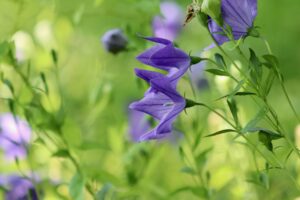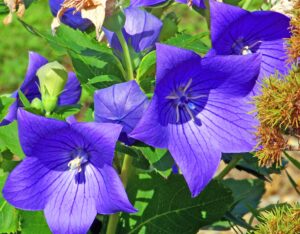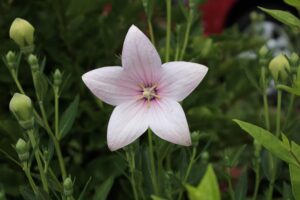The Platycodon, commonly known as the Balloon Flower, is a delightful and versatile addition to any garden. Its name derives from the unique balloon-like shape of its flower buds before they open. Belonging to the Campanulaceae family, Platycodon grandiflorus is the most well-known species within this genus. Native to East Asia, particularly China, Korea, Japan, and Siberia, the Balloon Flower is cherished not only for its ornamental beauty but also for its medicinal properties in traditional Asian medicine.

Balloon Flowers are herbaceous perennials, meaning they return year after year, bringing consistent beauty to gardens. They typically grow to a height of 12 to 24 inches, although some varieties can reach up to 36 inches. The plant features dark green, lance-shaped leaves and produces strikingly beautiful flowers that range in color from blue to white and pink. Each flower consists of five petals fused at the base, forming a star-shaped bloom that opens up after the distinctive balloon-like buds burst open.
Choosing the Right Location
Balloon Flowers thrive in full sun to partial shade. They prefer a location that receives at least 6 hours of sunlight daily, though they can tolerate some afternoon shade, especially in hotter climates. Ensure the planting site has well-drained soil, as Platycodon doesn’t fare well in soggy conditions.
Temperature and Humidity Requirement
Balloon Flowers thrive in temperatures ranging from 60-75°F (15-24°C) during their active growing season. They prefer cooler temperatures and perform best in temperate climates. Balloon Flowers can tolerate moderate heat, but they may struggle in regions with prolonged high temperatures exceeding 85°F (29°C). In such climates, providing afternoon shade can help prevent stress and sunscald.
Balloon Flowers prefer moderate humidity levels. Too much humidity can increase the risk of fungal diseases, while too little humidity can cause the plants to dry out quickly.

Soil Preparation
Before planting, enrich the soil with organic matter, such as compost or well-rotted manure. This will enhance soil fertility and improve drainage. Aim for a slightly acidic to neutral pH level (6.0-7.0).
Planting Steps
Plant Balloon Flowers in the spring after the last frost or in early fall.
Space plants about 12 to 18 inches apart to allow for adequate air circulation and growth.
Dig a hole twice as wide and as deep as the plant’s root ball. Place the plant in the hole, ensuring the top of the root ball is level with the soil surface. Fill in with soil and gently firm around the base.
Water thoroughly after planting to help establish the roots.
Watering
Keep the soil consistently moist, especially during the first growing season. Once established, Balloon Flowers are relatively drought-tolerant. Water deeply but infrequently, allowing the top inch of soil to dry out between waterings.
Fertilizing
Feed Balloon Flowers with a balanced, slow-release fertilizer in the spring. Avoid excessive nitrogen, which can lead to more foliage at the expense of blooms. A balanced 10-10-10 fertilizer applied once a year is usually sufficient.

Mulching
Apply a 2-3 inch layer of mulch around the base of the plants to retain moisture, regulate soil temperature, and suppress weeds. Organic mulches like shredded bark, compost, or straw work well.
Staking
Balloon Flowers can be prone to flopping, especially in rich soil or shaded locations. Stake taller varieties or use a flower support ring to keep them upright.
Deadheading and Pruning
Deadhead spent flowers to encourage continuous blooming and prevent self-seeding. In late fall, after the foliage dies back, cut the stems to ground level. This tidying up helps prepare the plant for a vigorous return in the spring.
Dormancy and Winter Care
Platycodon is hardy in USDA zones 3-8, which means it can withstand winter temperatures down to -30°F (-34°C) in dormant form. In colder regions within this range, applying a layer of mulch can help protect the roots from extreme cold.
Pests and Diseases
Balloon Flowers are generally pest-resistant. However, watch out for slugs, snails, and aphids. Treat infestations with appropriate organic or chemical controls. Ensure good air circulation to prevent fungal diseases like powdery mildew and root rot.

Propagating Balloon Flowers
Division
Balloon Flowers have a taproot system, making division challenging. It’s best to avoid disturbing mature plants. If necessary, divide them in early spring when new growth begins.
Seed Propagation
Allow seed pods to dry on the plant, then collect and store them in a cool, dry place.
Sow seeds indoors 6-8 weeks before the last frost. Press them lightly into the soil surface without covering, as they need light to germinate.
For germinating Platycodon seeds and nurturing young seedlings, maintain a temperature between 65-70°F (18-21°C). This encourages robust and healthy seedling development.
Transplant seedlings outdoors after the last frost, following the same planting steps as for mature plants.

Adding Balloon Flowers to Your Garden
Balloon Flowers make excellent companions to other perennials like coneflowers, and daylilies. Their unique blooms add height, texture, and visual interest to mixed borders and cottage gardens. Plant them in groups for a striking display or mix them with other plants for a more natural look.
Platycodon, the Balloon Flower, is a delightful addition to any garden, offering unique balloon-like buds and star-shaped blooms. With proper planting, growing, and care, these charming perennials will reward you with years of beauty and enjoyment. Whether you’re a seasoned gardener or a novice, Balloon Flowers are a joy to grow and a stunning highlight in any floral arrangement.
Happy gardening, and may your garden always be in bloom!
Feel free to share your experiences or ask any questions in the comments below. For more gardening tips and flower guides, stay tuned to MyGardensBloom.com!



